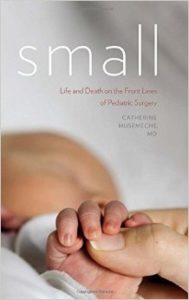Catherine Musemeche 2014
Dartmouth College Press
A review by Mark Davenport
 We all know that we are underappreciated – you only have to go to any of our meetings and conferences to listen to the chatter. But why is this, given that we work in a high-pressure, high-stress but yet all too visible profession and that our patients are generally the most vulnerable and heart-breaking in society… Surely we should be lauded and our paths strewn by palm leaves….well perhaps not.
We all know that we are underappreciated – you only have to go to any of our meetings and conferences to listen to the chatter. But why is this, given that we work in a high-pressure, high-stress but yet all too visible profession and that our patients are generally the most vulnerable and heart-breaking in society… Surely we should be lauded and our paths strewn by palm leaves….well perhaps not.
This book by an American paediatric surgeon who has crept under the radar as far as I was concerned redresses a little the balance; and is a conscious attempt to explain our field, our patch, our niche, to the most general of perhaps disinterested readers.
The book begins with a nice apposite poem by the American EB White “Hold a baby to your ear, as you would a shell…” (Conch – look it up, in case I have to pay a royalty!) and then we are straight in with hot operating lights, careless tube position by anesthetists, useless assistants and the howl of the plummeting of the saturation monitor.
Each of the twelve chapters are based upon individual scenarios and conditions, which are all very familiar and include diaphragmatic hernia, duodenal atresia, oesophageal atresia, rhabdomyosarcoma and inguinal hernia among them. What was intriguing however was the colouring in and embellishment of how we had got to where we were for each of them. So, the entire edifice of neonatal parental nutrition was really down to one surgical resident working at the University of Pennsylvania in 1967, Stanley Dudrick (still going strong by the way). He postulated the not unreasonable notion that to get enough calories in, then you had to concentrate the solution and therefore had to have it infusing in a high-flow central vein to avoid irritant damage to the vein wall. Easy concept, but a bit more difficult in real life so he used fine PVC catheters from the auto industry inserted via peripheral veins in puppies to prove the principle. On this background, and after some clinical use in a small group of adults he used his own customised parental nutrition formula in an infant with a closed gastroschisis and short gut (“Baby K”). He also re-infused plasma obtained after a high-fat diet in the parents to overcome fatty acid deficiency in their child – a parental parenteral solution as it were.
Similar stories are re-told in an engaging authoritative manner such as that of Bob Bartlett and his heart-lung ECMO machines. She recounts its first use in an infant who was the daughter of a Mexican illegal immigrant, dying on a ventilator with meconium aspiration syndrome in a Californian hospital in 1975. The baby survived but the mother disappeared into the night and the nurses named the baby Esperanza as a perfect summation of the crisis of the occasion (Spanish – hope).
Many professional readers will try to skip the paragraphs of exposition to get onto the nuggets of background they never knew about – but they really should saunter over the little things that actually do mean a lot. This is a fine book and a good read for those of us in the business but it also rises to the task of explaining to the parents on the other side, to the ordinary person in the street why many of us were so attracted in the first place to the pressure, the challenge and the chance to look after, rescue or re-shape the destiny of those newly-born.